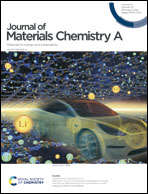“Sabatier principle” of d electron number for describing the nitrogen reduction reaction performance of single-atom alloy catalysts†
Abstract
The recently emerged single-atom alloy (SAA) catalysts have the combined merits of single-atom catalysts (SACs) and alloy catalysts, thus showing great potential for driving nitrogen reduction reactions (NRR). However, a rigorous design principle for novel SAAs toward achieving efficient NRR is still lacking. Herein, by means of density functional theory (DFT) calculations, we constructed 108 Cu-based SAAs to screen their inherent structure–activity relationship for driving electrochemical NRR. We found a quintuple degenerate d electron state in SAAs, and the d electrons could redistribute to the functional orbitals within the frame of the “acceptance–donation” mechanism for N2 activation. The d electron number (Ne) of the doped transition metal (TM) atom has been identified as a descriptor for evaluating the NRR activity with a relationship akin to the “Sabatier principle”, and a moderate Ne of 5 is optimal. Among all the SAAs, the best NRR was realized by Re–Cu(553) with the lowest overpotential of 0.17 V. Moreover, a machine-learning (ML) method to describe and thus regulate all characteristics of the Cu-based SAAs is presented, which unveiled the intrinsic correlations between their structure and catalytic performance. This work provides a comprehensive insight for NRR applied by SAAs, paving the way to discovering novel catalysts toward high NRR performance.



 Please wait while we load your content...
Please wait while we load your content...